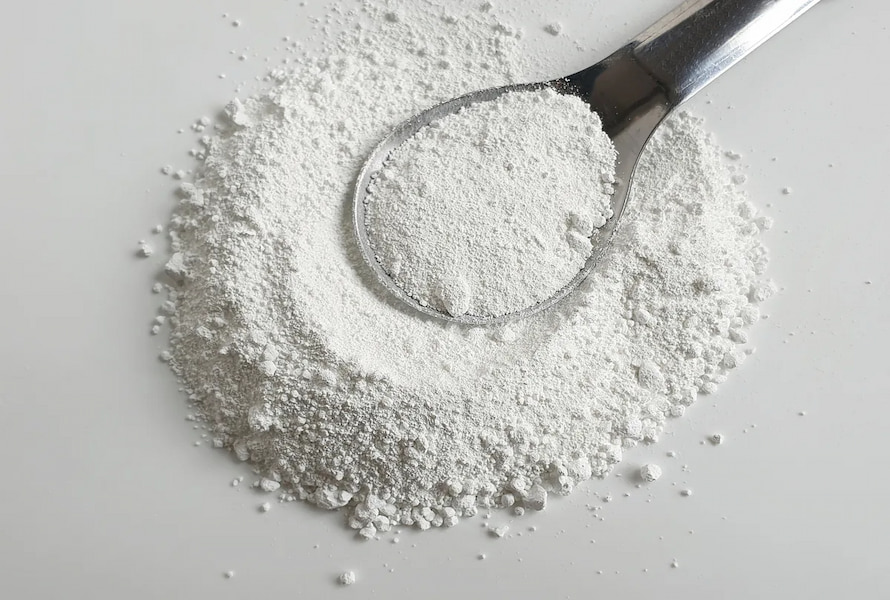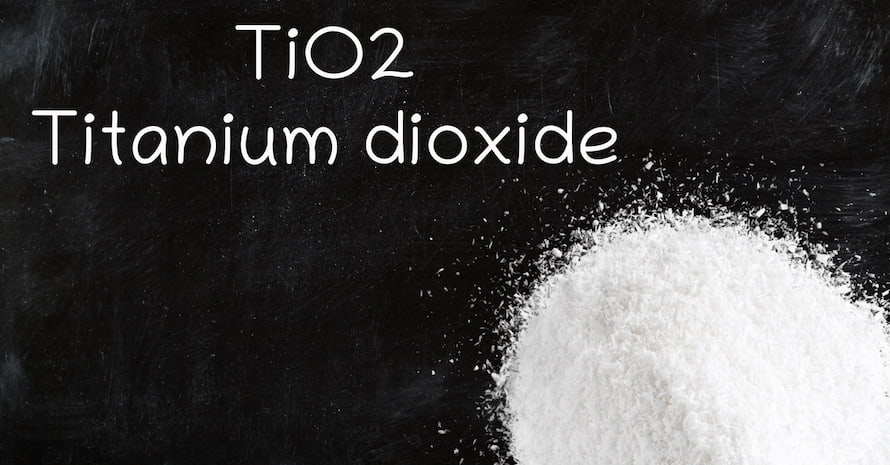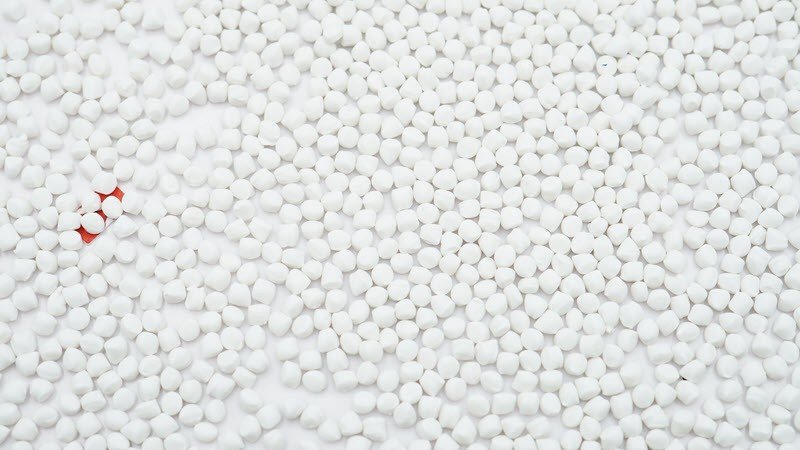
Titanium dioxide (TiO2) is a naturally occurring mineral that has been used for centuries in a variety of applications. In recent years, it has become an increasingly popular additive in the plastics industry due to its unique properties and ability to improve the appearance and performance of plastic products. In this article, we will explore what titanium dioxide is and the benefits of using it in plastic.
1. What is titanium dioxide?

Definition: Titanium(IV) oxide or titanium dioxide, titania, is a naturally occurring inorganic compound in the oxide form of titanium. It goes by the names titanium white, Pigment White 6, or CI 77891 when used as a dye. Titanium dioxide is one of the most commonly used materials in the world, with an annual production of over 4 million tons.
- Molecular Formula: O2Ti or TiO2
- Melting point: 1.843 °C
- Density: 4.23 g/cm³
- Molecular weight: 79,866 g/mol
- Boiling point: 2.972 °C
Properties
- Titanium dioxide is a white, odorless, and tasteless powder.
- Optical Properties: Thanks to its high refractive index, titanium dioxide has high opacity, whiteness, and brightness.
- Chemical Stability: Titanium dioxide is chemically stable and does not react with most chemicals, including acids and bases.
- Thermal Stability: Titanium dioxide is thermally stable and can withstand high temperatures without losing its properties.
- Electrical Properties: Titanium dioxide is an excellent electrical insulator, with low electrical conductivity.
Applications
- Architectural, automotive, and industrial coatings.
- Sunscreens and other personal care products.
- Glaze in ceramics or raw material in the manufacturing of ceramic pigments.
- Filler in paper or a coating on paper to improve its printing properties
- Catalyst in various chemical reactions, including the oxidation of organic compounds and the production of hydrogen gas.
- Used in the manufacturing of medical implants, such as dental implants, hip and knee replacements, and pacemaker casings.
2. Titanium dioxide used in plastic
2.1. Improve the heat resistance

Titanium dioxide (TiO2) is commonly used as a white pigment in the plastic industry to improve the heat resistance ability of plastic products. When titanium dioxide is added to plastic, it acts as a nucleating agent, which means it helps to promote the formation of crystalline structures within the plastic. These crystalline structures provide reinforcement to the plastic, improving its strength and durability. At high temperatures, the crystalline structures become more stable and can better resist deformation and melting.
The heat resistance of plastics can be improved by using titanium dioxide in several ways.
- Increase the melting point of plastic: By increasing the melting point, the plastic can withstand higher temperatures before melting, making it more suitable for use in high-temperature applications.
- Improve the thermal stability of plastics: It helps plastics better resist deformation and degradation at high temperatures, making them more durable and reliable.
2. Improve the light resistance
In addition to its heat resistance benefits, titanium dioxide also improves the light resistance of plastics, helping them be more resistant to fading and discoloration when exposed to sunlight or other sources of light.
The mechanism by which titanium dioxide improves the light resistance of plastics is through its ability to scatter and absorb light. When added to plastic, titanium dioxide particles scatter light in all directions, which reduces the amount of light that penetrates the plastic. This reduces the amount of light energy that is absorbed by the plastic, which in turn reduces the rate of photo-degradation. The scattering and reflection of light by the titanium dioxide particles effectively act as a shield, protecting the plastic from the damaging effects of light exposure.
Moreover, titanium dioxide has a high refractive index, which means that it bends and slows down light more than other materials. This property allows titanium dioxide to disperse light evenly throughout the plastic, resulting in a more uniform appearance and reducing the likelihood of hotspots or uneven discoloration.
2.3. Enhance plastic weather resistance

Plastics are vulnerable to weather factors such as sunlight, moisture, and temperature fluctuations, which can cause them to degrade and lose their mechanical properties. Titanium dioxide is an effective additive that can help to mitigate these effects and improve the weather resistance of plastics.
One of the primary ways in which titanium dioxide enhances the weather resistance of plastics is through its ability to absorb ultraviolet (UV) radiation. TiO2 is a highly effective UV absorber, and when added to plastic, it can absorb UV radiation from sunlight, preventing it from reaching the polymer chains. By absorbing the UV radiation, TiO2 prevents the formation of electron-hole pairs, slowing down the rate of photo-degradation and extending the lifespan of the plastic product.
Titanium dioxide also acts as a barrier to moisture and other environmental factors. When added to plastic, TiO2 particles create a barrier that prevents moisture and other environmental factors from penetrating the plastic. This helps to reduce the effects of weathering, such as cracking and warping and protects the plastic from degradation caused by exposure to the elements.
Furthermore, titanium dioxide can also be used as a filler material in plastics. As a filler, it improves the mechanical properties of plastics, such as their stiffness, toughness, and impact resistance. This makes the plastic more resistant to the effects of weathering and other environmental factors, enhancing its weather resistance.
2.4. Coloring plastic

Titanium dioxide is a highly effective pigment, and when added to plastic, it can make the product white, opaque, and highly reflective. Therefore, this material is widely used in the plastic industry to produce white masterbatch, which is used to color plastics white.
Titanium dioxide achieves its white pigmenting effect through a process known as Mie scattering. When light enters a plastic product containing TiO2 particles, the light waves interact with the particles and are scattered in all directions. This scattering effect is strongest in the short-wavelength range of visible light, which includes blue and violet light. As a result, TiO2 particles appear white in color, as they reflect all colors of visible light.
The effectiveness of titanium dioxide as a white pigment is due to its high refractive index, which is a measure of how much light is bent when it passes through a medium. TiO2 has a refractive index of 2.55, which is higher than most other pigments used in plastics. This means that TiO2 particles are able to scatter light more effectively, producing a whiter, more opaque color.
2.5. Improve the mechanical and electrical properties of plastic

Finally, titanium dioxide is also used to improve the mechanical and electrical properties of plastic. When added to plastic, TiO2 can enhance the strength, stiffness, toughness, and impact resistance of the material, making it more durable and resistant to deformation.
TiO2's capacity to function as a reinforcing filler is one of the main factors contributing to its ability to enhance the mechanical properties of plastic. This happens as a result of the minuscule TiO2 particles' ability to engage with the plastic's polymer chains and forge a more robust and rigid structure. Due to the increased surface area of TiO2 particles, there are more points of contact between the particles and the polymer matrix, which improves the material's mechanical properties.
In addition to mechanical properties, TiO2 can also improve the electrical properties of plastic. This is because TiO2 is an effective insulator and may aid in lowering the electrical conductivity of plastic items. Under some circumstances, TiO2 may also function as a dielectric or a substance that can store and discharge electrical energy.
Using TiO2 as a plastic addition also has the benefit of enhancing the material's dimensional stability. This is crucial in situations when exact dimensions and tolerances are necessary, such as when making machine components or molds. TiO2 may be used to prevent plastic shrinkage during cooling and curing, resulting in a more consistent and predictable end product.
In short, the benefits of using titanium dioxide in plastic are numerous and significant. This naturally occurring mineral is able to enhance the performance and quality of plastic products. By adding titanium dioxide to plastic, manufacturers can create stronger, more durable, and more aesthetically pleasing products that are able to withstand exposure to sunlight, heat, and other environmental factors.